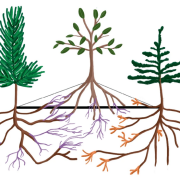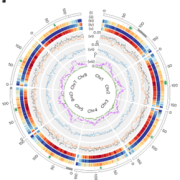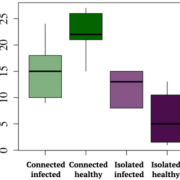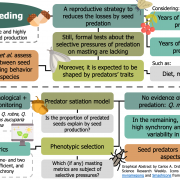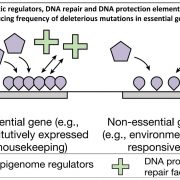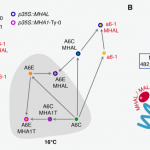Genomic mechanisms of climate adaptation in polyploid bioenergy switchgrass (Nature)
 Switchgrass (Panicum virgatum) is a tall, perennial species native to the prairies of North America. Switchgrass is well-known for its uses as a biofuel and forage crop. However, switchgrass is also a fascinating model to investigate how plants adapt to changing environments, as historical glacial cycles caused the switchgrass habitat to expand and contract several times. Here, Lovell et al. share a high-quality, well-annotated genome assembly for switchgrass, which is no mean feat given that this is a highly heterozygous tetraploid species. The authors sequenced 732 switchgrass genotypes and cultivated them at sites spanning over 1,800 km of latitude, from southern Texas to South Dakota. Three genetically and geographically distinct subpopulations were identified, appropriately named Midwest, Atlantic, and Gulf. Genome-wide association mapping revealed several climate–gene–biomass associations that differed between the subpopulations. Moreover, the authors discovered that during the Atlantic subpopulation’s colonization of the colder, northeastern regions of the USA, climate adaptation was augmented by the introgression of alleles from the already-adapted Midwest gene pool. This impressive study provides a wealth of genomic resources and gene–trait associations that will aid switchgrass breeding efforts. Additionally, this research provides valuable insights into how switchgrass withstands rapid environmental alterations, which will be crucial to bolstering other plant species amid climate change. (Summary by Caroline Dowling @CarolineD0wling) Nature 10.1038/s41586-020-03127-1
Switchgrass (Panicum virgatum) is a tall, perennial species native to the prairies of North America. Switchgrass is well-known for its uses as a biofuel and forage crop. However, switchgrass is also a fascinating model to investigate how plants adapt to changing environments, as historical glacial cycles caused the switchgrass habitat to expand and contract several times. Here, Lovell et al. share a high-quality, well-annotated genome assembly for switchgrass, which is no mean feat given that this is a highly heterozygous tetraploid species. The authors sequenced 732 switchgrass genotypes and cultivated them at sites spanning over 1,800 km of latitude, from southern Texas to South Dakota. Three genetically and geographically distinct subpopulations were identified, appropriately named Midwest, Atlantic, and Gulf. Genome-wide association mapping revealed several climate–gene–biomass associations that differed between the subpopulations. Moreover, the authors discovered that during the Atlantic subpopulation’s colonization of the colder, northeastern regions of the USA, climate adaptation was augmented by the introgression of alleles from the already-adapted Midwest gene pool. This impressive study provides a wealth of genomic resources and gene–trait associations that will aid switchgrass breeding efforts. Additionally, this research provides valuable insights into how switchgrass withstands rapid environmental alterations, which will be crucial to bolstering other plant species amid climate change. (Summary by Caroline Dowling @CarolineD0wling) Nature 10.1038/s41586-020-03127-1


